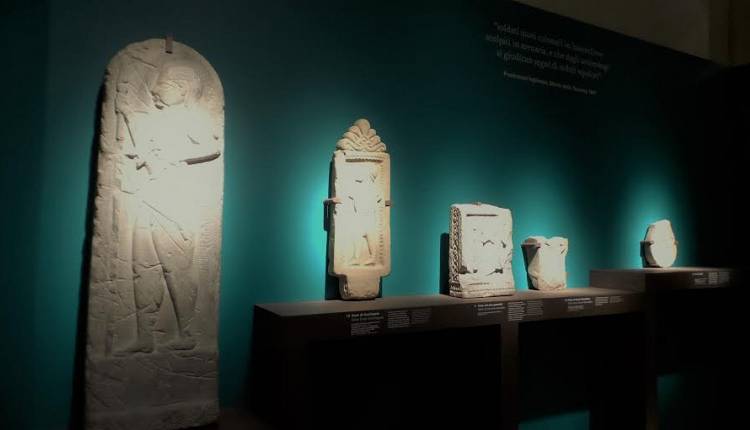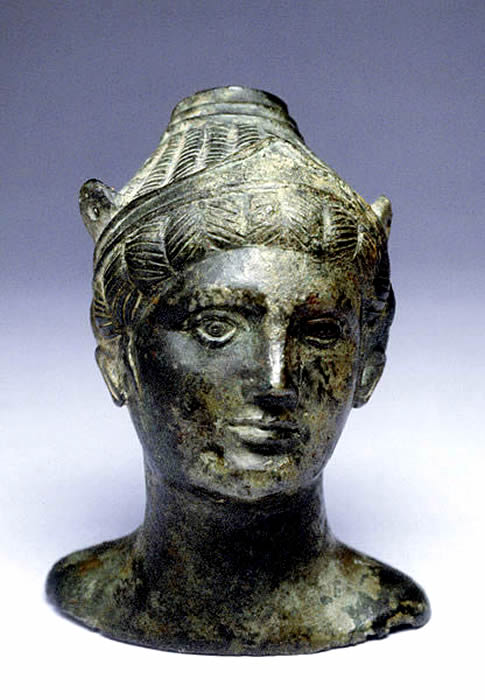Angela
Elite member
- Messages
- 21,823
- Reaction score
- 12,329
- Points
- 113
- Ethnic group
- Italian
It's being billed as one of the greatest discoveries about the Etruscans in decades, or it will be when all of the inscription is translated.
See:
http://www.archaeology.org/news/4792-160826-etruscan-stele-uni
Among the words is the name given to the Etruscan fertility goddess at this site: Uni
"Discovery News reports that scholars have completed a preliminary reading of the text inscribed on a sandstone stele unearthed at an Etruscan sanctuary in Italy’s Mugello Valley. The 2,500-year-old stele measures about four feet tall by two feet wide, and was found in the foundation of a temple at the site of Poggio Colla. The text, made up of more than 120 characters, has been damaged. “Cleaning at a restoration center in Florence has allowed better visibility of the inscribed signs, making it possible to identify a larger sequence of letters and words,” said researcher Adriano Maggiani. Among the words is the name of the goddess Uni, consort of the Etruscan supreme deity, Tinia. The team members of the Mugello Valley Archaeological Project think the sanctuary where the stele was found may have been dedicated to Uni. They have also recovered weaving tools, pottery, and gold jewelry that point to the worship of a fertility goddess."
See also this Science news article:
https://www.sciencedaily.com/releases/2016/08/160824135508.htm
"[FONT="]The discovery indicates that Uni -- a divinity of fertility and possibly a mother goddess at this particular place -- may have been the titular deity worshipped at the sanctuary of Poggio Colla, a key settlement in Italy for the ancient Etruscan civilization.[/FONT][FONT="]The mention is part of a sacred text that is possibly the longest such Etruscan inscription ever discovered on stone, said archaeologist Gregory Warden, professor emeritus at Southern Methodist University, Dallas, main sponsor of the archaeological dig.[/FONT]
[FONT="]Scientists on the research discovered the ancient stone embedded as part of a temple wall at Poggio Colla, a dig where many other Etruscan objects have been found, including a ceramic fragment with the earliest birth scene in European art. That object reinforces the interpretation of a fertility cult at Poggio Colla, Warden said."
This is the carving of the birth. It makes sense if this was a place of worship of the fertility goddess.
https://s-media-cache-ak0.pinimg.com/236x/bc/2a/de/bc2ade90909ba23e99e42bfb3e3cd33a.jpg
This is a site about Uni:
https://s-media-cache-ak0.pinimg.com/236x/bc/2a/de/bc2ade90909ba23e99e42bfb3e3cd33a.jpg
She was the forerunner of Juno, but seems to have had more power, which makes sense for an Etruscan female deity: she was the protectress of many cities, and of women, and had the ability to hurl thunderbolts to help her. In Italian mythology she was held to be the mother of Hercules.
In Italian mythology she was held to be the mother of Hercules.
"[FONT="]The worship of Juno in Rome was traditionally said to have been brought there from the great Etruscan city of Veia (Latin Veii), about 11 miles northwest of Rome, so my guess is that the Latin derives from the Etruscan and Uni is first."
"[/FONT][FONT="]Uni had two sanctuaries in Pyrgi (the Latin name of the city), the port of the city of Cisra or Chaisra: the older one dates to the 6th century BCE, the newer one to the 5th century, and both are dedicated to Her as Uni-Astarte."
[/FONT][FONT="]"[/FONT][FONT="]Classical writers referred to Her temple at Pyrgi as belonging to Ilithiya or Lucina, Greek and Roman names, respectively, of Birth-Goddesses, suggesting that Uni's cult in Pyrgi was especially focussed on Her aspect as Mother and Childbirth Goddess; however this must have been only one of Her facets worshipped there,"
[/FONT][FONT="]
[/FONT]This is an Etruscan pendant of a woman carrying a child:

Some of my favorite Etruscan representations of women:

These look medieval, not pre-Roman.

 The Etruscan site at Poggio Colla:[/FONT]
The Etruscan site at Poggio Colla:[/FONT]
https://en.wikipedia.org/wiki/Poggio_Colla
"Thus far, the identified seeds includes cereal, mainly barley, wheat, broad beans, chickpeas, and grape pips. "
"The faunal remains recovered from Poggio Colla primarily contains the remains of cattle, sheep/goat and pig, as well as the remains of dog and wild species. The relative importance of pigs increases over time; this trend is linked to intensification of meat production and rising urban populations. Similar faunal assemblages have been found in other Etruscan settlements.A black-glaze olpe filled with one hundred Roman silver victoriati was discovered in 2001 in the west end of the Poggio Colla acropolis. The significance of the finding is that it is found in a sanctuary; and it was buried after the sanctuary was destroyed in the late 3rd century BCE."
These are stele from the area:

See:
http://www.archaeology.org/news/4792-160826-etruscan-stele-uni
Among the words is the name given to the Etruscan fertility goddess at this site: Uni
"Discovery News reports that scholars have completed a preliminary reading of the text inscribed on a sandstone stele unearthed at an Etruscan sanctuary in Italy’s Mugello Valley. The 2,500-year-old stele measures about four feet tall by two feet wide, and was found in the foundation of a temple at the site of Poggio Colla. The text, made up of more than 120 characters, has been damaged. “Cleaning at a restoration center in Florence has allowed better visibility of the inscribed signs, making it possible to identify a larger sequence of letters and words,” said researcher Adriano Maggiani. Among the words is the name of the goddess Uni, consort of the Etruscan supreme deity, Tinia. The team members of the Mugello Valley Archaeological Project think the sanctuary where the stele was found may have been dedicated to Uni. They have also recovered weaving tools, pottery, and gold jewelry that point to the worship of a fertility goddess."
See also this Science news article:
https://www.sciencedaily.com/releases/2016/08/160824135508.htm
"[FONT="]The discovery indicates that Uni -- a divinity of fertility and possibly a mother goddess at this particular place -- may have been the titular deity worshipped at the sanctuary of Poggio Colla, a key settlement in Italy for the ancient Etruscan civilization.[/FONT][FONT="]The mention is part of a sacred text that is possibly the longest such Etruscan inscription ever discovered on stone, said archaeologist Gregory Warden, professor emeritus at Southern Methodist University, Dallas, main sponsor of the archaeological dig.[/FONT]
[FONT="]Scientists on the research discovered the ancient stone embedded as part of a temple wall at Poggio Colla, a dig where many other Etruscan objects have been found, including a ceramic fragment with the earliest birth scene in European art. That object reinforces the interpretation of a fertility cult at Poggio Colla, Warden said."
This is the carving of the birth. It makes sense if this was a place of worship of the fertility goddess.
https://s-media-cache-ak0.pinimg.com/236x/bc/2a/de/bc2ade90909ba23e99e42bfb3e3cd33a.jpg
This is a site about Uni:
https://s-media-cache-ak0.pinimg.com/236x/bc/2a/de/bc2ade90909ba23e99e42bfb3e3cd33a.jpg
She was the forerunner of Juno, but seems to have had more power, which makes sense for an Etruscan female deity: she was the protectress of many cities, and of women, and had the ability to hurl thunderbolts to help her.
"[FONT="]The worship of Juno in Rome was traditionally said to have been brought there from the great Etruscan city of Veia (Latin Veii), about 11 miles northwest of Rome, so my guess is that the Latin derives from the Etruscan and Uni is first."
"[/FONT][FONT="]Uni had two sanctuaries in Pyrgi (the Latin name of the city), the port of the city of Cisra or Chaisra: the older one dates to the 6th century BCE, the newer one to the 5th century, and both are dedicated to Her as Uni-Astarte."
[/FONT][FONT="]"[/FONT][FONT="]Classical writers referred to Her temple at Pyrgi as belonging to Ilithiya or Lucina, Greek and Roman names, respectively, of Birth-Goddesses, suggesting that Uni's cult in Pyrgi was especially focussed on Her aspect as Mother and Childbirth Goddess; however this must have been only one of Her facets worshipped there,"
[/FONT][FONT="]
[/FONT]This is an Etruscan pendant of a woman carrying a child:

Some of my favorite Etruscan representations of women:

These look medieval, not pre-Roman.


https://en.wikipedia.org/wiki/Poggio_Colla
"Thus far, the identified seeds includes cereal, mainly barley, wheat, broad beans, chickpeas, and grape pips. "
"The faunal remains recovered from Poggio Colla primarily contains the remains of cattle, sheep/goat and pig, as well as the remains of dog and wild species. The relative importance of pigs increases over time; this trend is linked to intensification of meat production and rising urban populations. Similar faunal assemblages have been found in other Etruscan settlements.A black-glaze olpe filled with one hundred Roman silver victoriati was discovered in 2001 in the west end of the Poggio Colla acropolis. The significance of the finding is that it is found in a sanctuary; and it was buried after the sanctuary was destroyed in the late 3rd century BCE."
These are stele from the area:







